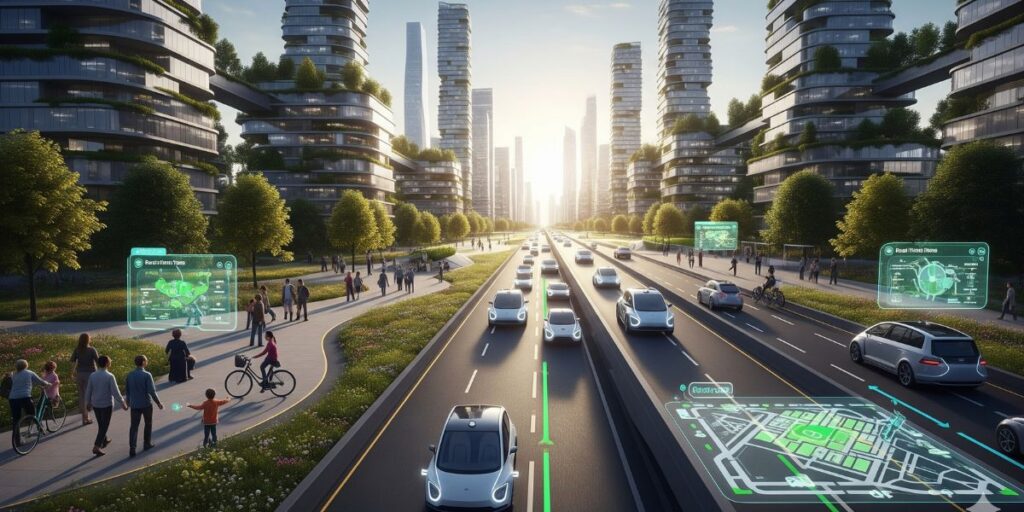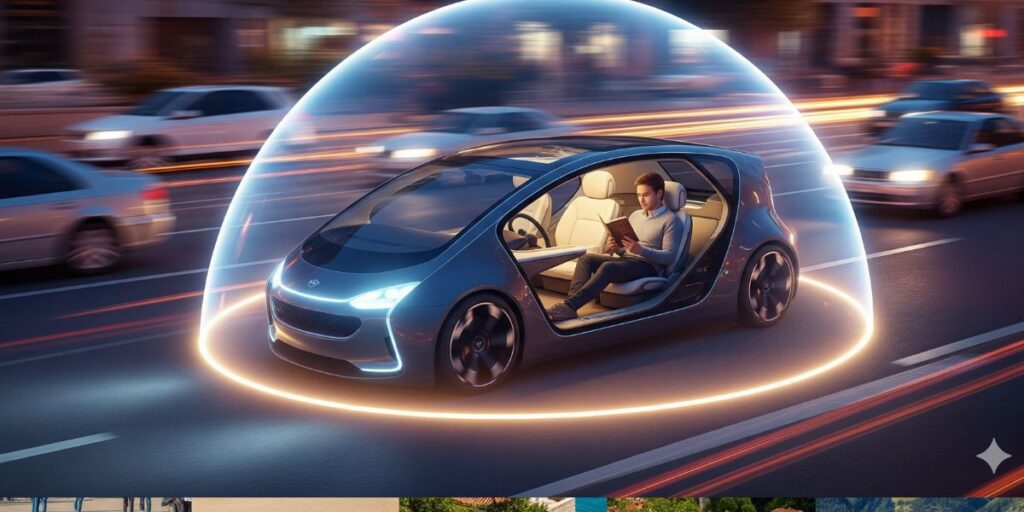Imagine your morning commute. The stop-and-go traffic, the stress of a near-miss, the constant need for attention and focus. Now, imagine that same journey, but you’re in a comfortable chair, sipping your coffee, reading a book, or catching up on emails while your car navigates the complexities of the road with silent, precise efficiency. This is the promise of autonomous vehicles, a world where the chore of driving is replaced by the luxury of time.
For some, this vision is a utopian dream, a future defined by safer roads, less congestion, and newfound freedom for millions. For others, it’s a technological nightmare, a terrifying surrender of control to a machine that could make a catastrophic error in a split second. This isn’t just a simple technological evolution; it’s a profound shift in how we live, work, and move. The debate around autonomous vehicles is one of the most significant conversations of our time, and the question remains: are they the salvation of our roads, or the start of a whole new set of problems?
The Dream: The Promise of a Safer, Simpler Future

The case for autonomous vehicles is compelling, and it starts with the most critical factor of all: safety. Human error is the cause of over 94% of all traffic accidents, according to the National Highway Traffic Safety Administration. We get distracted, we get tired, we drive under the influence, and we make split-second mistakes.
A self-driving car, in theory, doesn’t do any of those things. It doesn’t get sleepy on a long drive, it doesn’t text and drive, and its sensors have a 360-degree view of the road that no human ever could. This is the core dream of autonomous vehicles: a future where car accidents become a rare relic of the past.
Beyond safety, the benefits feel almost too good to be true. Think about the time you could reclaim. For the average American, the time spent commuting is a significant portion of their day. An autonomous car transforms this “dead time” into productive or recreational time. You could prepare for a meeting, watch an episode of your favorite show, or simply relax and enjoy the scenery. This isn’t just about convenience; it’s about fundamentally changing the way we value and use our time.

Furthermore, autonomous vehicles could revolutionize urban planning and traffic flow. These cars could communicate with each other, creating a perfectly synchronized flow of traffic with no sudden stops or unnecessary braking. This would not only reduce congestion but also drastically cut down on fuel consumption and emissions.
The environmental impact alone could be a massive step forward. For individuals with disabilities or the elderly who are unable to drive, autonomous vehicles offer a lifeline of mobility and independence, connecting them to their communities in a way that wasn’t possible before.
The Danger: Navigating the Ethical and Technical Minefield
While the dream is alluring, the reality of the challenges posed by autonomous vehicles is sobering. The fear isn’t just about the technology failing; it’s about what happens when it works perfectly but is forced to make an impossible choice. This is the modern-day “trolley problem” in a real-world scenario. If a self-driving car is faced with a situation where a collision is unavoidable, should it swerve to save its passengers but risk hitting a pedestrian? Or should it prioritize the pedestrian and risk the lives of those inside? These are deeply complex ethical dilemmas that engineers and ethicists are still debating.

Then there’s the question of security. If a car is essentially a computer on wheels, it’s vulnerable to hacking. A malicious actor could take control of a vehicle, reroute it, or worse. The data privacy implications are also enormous. For an autonomous car to function, it needs to constantly collect and process data about its surroundings, its passengers, and its routes. Who owns this data? How is it protected? These are not small questions; they are fundamental to our personal security and privacy in a world of autonomous vehicles.
Finally, we have the economic impact. The promise of a future without drivers is a threat to millions of jobs, from truck drivers and taxi drivers to delivery professionals. While some argue that new jobs will emerge to support this industry, the transition could be incredibly disruptive and lead to widespread unemployment. The societal implications of this kind of job displacement are a significant part of the debate.
Where We Are Today: Beyond the Hype and the Headlines

When we talk about autonomous vehicles, it’s easy to get caught up in either a utopian or dystopian vision. But the reality is far more nuanced. We are currently living in a transitionary period, where many of us already use semi-autonomous features without even thinking about it.
Think about the cars on the road today with features like adaptive cruise control, lane-keeping assist, and automatic emergency braking. These are all stepping stones on the path to fully autonomous vehicles. The Society of Automotive Engineers (SAE) has a well-known scale from Level 0 (no automation) to Level 5 (full automation). Today, most of the advanced cars on the market are at Level 2, meaning they can perform some functions but a human driver must remain fully engaged and ready to take over.
The most visible progress, and sometimes the biggest source of controversy, has come from companies like Tesla and Waymo. Their vehicles are pushing the boundaries, but they also face a lot of public scrutiny. Every incident, no matter how rare, makes headlines and fuels the public’s fear. This is a crucial part of the debate: the perception of safety is just as important as the actual safety statistics. For the average person, one viral video of a self-driving car making a mistake can erase years of progress and safety data. Autonomous vehicles are based on algorithm, and i think we have a long way to go to improve our algorithm technology.
The Trust Factor: Building Confidence in the Machine

The widespread adoption of autonomous vehicles won’t just happen because the technology is ready. It will happen when people are ready to trust it. This isn’t a small leap of faith; it’s a cultural shift. And that trust must be earned through a number of key initiatives:
- Robust Regulation: Clear, consistent, and well-enforced regulations are essential. People need to know that these vehicles have been tested thoroughly and adhere to strict safety standards.
- Transparent Data: Companies must be transparent about how their systems work and what data they are collecting. This addresses the privacy concerns and helps build confidence in the technology’s integrity.
- Public Education: We need to move beyond sensationalist headlines and provide the public with clear, accurate information about the technology. Explaining the difference between Level 2 and Level 5 automation, for instance, can help manage expectations and reduce fear.
- Gradual Integration: Instead of a sudden, widespread rollout, autonomous vehicles will likely be introduced in phases, starting in well-mapped, controlled environments and gradually expanding. This gradual approach allows the public to get used to the technology and builds trust over time.
Frequently Asked Questions

Q1: How soon will autonomous vehicles be widespread?
This is a complex question with no simple answer. While we have some cars with limited self-driving capabilities on the road today, the widespread adoption of fully autonomous vehicles (Level 5) is still a long way off. Most experts predict a gradual transition over the next few decades, with Level 4 vehicles becoming more common in certain areas within the next 5-10 years.
Q2: Will I need a driver’s license for an autonomous vehicle?
For now, yes. With the current levels of automation (Level 2-3), a human driver is still required to be present and ready to take over. For fully autonomous vehicles (Level 5), which are not yet available to the public, a license may not be required at all, but this will depend on future regulations.
Q3: Are they truly safe in bad weather?
Bad weather is one of the biggest challenges for autonomous vehicles. Sensors like LiDAR and cameras can be affected by heavy snow, rain, or fog, which can obscure their view. While companies are actively working on solutions, a fully autonomous car that can handle all weather conditions as well as a human driver remains a significant engineering hurdle.
The Final Verdict: A Dream Worth Pursuing with Caution
The debate over autonomous vehicles is not about whether the technology is a dream or a danger in a vacuum. It is about how we, as a society, choose to develop and integrate it. The dream of a safer, more efficient, and more accessible world is a powerful one. The dangers, the ethical quandaries, the security risks, the social disruption, are real and must be addressed with the utmost care.
The path forward is not to abandon this technology out of fear but to approach it with a balanced, clear-eyed perspective. It requires a partnership between innovators, regulators, ethicists, and the public. By building robust regulations, fostering transparency, and investing in public education, we can create a future where the promise of autonomous vehicles outweighs the perils. The journey ahead will be complex, but the destination, a world where our roads are safer, our time is our own, and our mobility is no longer a privilege, is a dream worth navigating with purpose.
You might also want to read about, why your next big idea needs nano banana AI.



